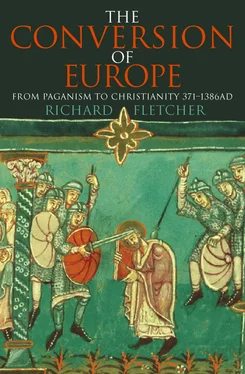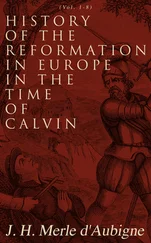Gregory saw visions. He was commanded to accept the bishopric of Neocaesarea by St John and St Mary – the earliest recorded vision of the Blessed Virgin in Christian history – who recited to him the creed which he should profess. According to Gregory of Nyssa, this credal statement was preserved in the cathedral of Neocaesarea in an autograph copy: ‘the very letters inscribed by his own blessed hand’. The cathedral itself had been built by Gregory. It was a new landmark among the city’s public buildings, and one moreover which did not suffer in an earthquake the damage experienced by secular buildings. Already one may detect some elements of what may have been going on. Gregory enjoyed direct access to the divine; a relic of his, a document from his hand, is venerated; God’s house built by him is miraculously preserved. A bishop such as this will command authority and prestige.
Then there were his wonders. Two brothers were quarrelling over the ownership of a lake. Their enmity had gone so far that they were preparing to arm their peasants and fight it out together. Gregory appeared on the scene as a mediator. At a twitch of his cloak the lake dried up and disappeared for ever. On another occasion the river Lycus was flooding and threatening damage. Gregory planted his staff on its bank to mark the limit beyond which the waters must not pass and the waters (of course) obeyed him. The staff grew into a tree which was still being pointed out to people a century later when Gregory of Nyssa recorded the story. Well, it’s not difficult to see how that story arose. But such a comment as this misses what would have been the point of the tale for those who told it to Gregory of Nyssa or heard it from him. God acted through Gregory to work wonders which healed human divisions and tamed the forces of nature. Demonstrations of supernatural powers – frequently in competition with non-Christian claimants to possess such powers – will meet us again and again. Almost invariably we are told that they led to conversions. What that might have meant is another matter.
Finally there was Gregory’s public role as bishop. He built a new cathedral, as we have seen. He interceded for his flock during an outbreak of plague, did what he could to shield them during the Decian persecution. In troubled times he was a force for order and stability. His Canonical Letter , to which we shall return in Chapter 3, shows him grasping at scriptural precept to assist in sorting out the harrowing human consequences of barbarian attack. This enlargement of a bishop’s responsibilities was to have a long and fruitful future.
Why did efforts to convert the country-dwellers begin, in however patchy and hesitant a fashion, in the course of the third century? It is a question which has never satisfactorily been answered. It may be that the trend towards near-identification of Romanitas with Christianitas , of empire with Christendom, rendered it desirable, even necessary, for all Romans to become Christians. ‘All Romans’ would mean all Roman citizens , a group which had been vastly enlarged by the so-called Constitutio Antoniana of the year 212, by which the government of the Emperor Caracalla extended the privileges and responsibilities of citizenship to all free men. (There were, of course, enormous numbers of country-dwellers who were not free.) Another factor, less nebulous and offering at least the possibility of investigation, might have been the changing social composition of the bishops who ruled the churches. Historians are agreed that the third century was marked by a steady if obscure growth in Christian numbers. Numerical increase was matched by increase in respectability. It would be possible to compile a list – granted, not a long list – of third-century Christians of some not inconsiderable social standing. Gregory the Wonder-worker is a good example. Persons of such rank and wealth who became bishops might be expected to be solicitous for the spiritual well-being of the peasantry on their estates, apprehensive of their vulnerability to demonic attack, despite the entrenched attitudes alluded to in the preceding chapter; and their example might be the more infectious to others who shared their status. What were the peasantry of the feuding brothers of Pontus encouraged to think when they were told to put their weapons away and get back to their fields? It is an interesting question.
After the imperial adhesion to Christianity under Constantine, never to be reversed except during the brief reign of Julian, the Christian community within the empire underwent phenomenal growth – which changed its character. Imperial patronage colossally increased the wealth and status of the churches. Privileges and exemptions granted to Christian clergy precipitated a stampede into the priesthood. Devout aristocratic ladies acquired followings of clerical groupies, experimented with fashionable forms of devotion. Christian moralists were apprehensive that conversions were occurring for the wrong reasons – to gain favour, to obtain a job, promotion, a pension. As far as the historian can tell, their anxieties do not appear to have been misplaced. Fashion is a great force in human affairs. The adherence of the establishment to Christianity in the course of the fourth century made more urgent than ever the task of converting the outsiders on whose labours the establishment rested: the huge majority who toiled in the countryside.
The process by which the empire became officially Christian may be said to have been completed in the course of the reign of Theodosius I (379–95). A cluster of events and decisions mark this: the defeat of an avowedly pagan military coup, the issue of legislation formally banning pagan worship, the removal of the Altar of Victory from the senate house in Rome, the destruction of the temple of the god Serapis at Alexandria. Some of the markers are uncomfortable portents: the first execution of a heretic (the Spaniard, Priscillian, in 385), and a rising tide of Christian anti-Semitism. It is surely not coincidental that it is from this period that influential voices can be heard urging landowners to make their peasantry Christian. Here is John Chrysostom, John ‘the golden-mouthed’, the most fashionable preacher of his day, patriarch of Constantinople between 398 and 404, preaching in the capital in the year 400 to an upper-class audience living, we presume, in their town houses, about their responsibilities to those on their landed estates.
Many people have villages and estates and pay no attention to them and do not communicate with them, but do give close attention to how the baths are working, and how halls and palaces are constructed – not to the harvest of souls … Should not everyone build a church? Should he not get a teacher to instruct the congregation? Should he not above all else see to it that all are Christians? 3
And here is Augustine, congratulating Pammachius in 401 on ‘the zeal with which you have chased up those peasants of yours in Numidia’, and brought them back to Catholic unity. (Pammachius had converted them, not indeed from paganism to Christianity, but from deviancy in schism back to orthodoxy, but that does not weaken the point.) And here, finally, is Maximus, bishop of Turin from c. 398 to c. 412, and another famous preacher, in one of his sermons.
You should remove all pollution of idols from your properties and cast out the whole error of paganism from your fields. For it is not right that you, who have Christ in your hearts, should have Antichrist in your houses, that your men should honour the devil in his shrines while you pray to God in church. And let no one think he is excused by saying: ‘I did not order this, I did not command it.’ Whoever knows that sacrilege takes place on his estate and does not forbid it, in a sense orders it. By keeping silence and not reproving the man who sacrifices, he lends his consent. For the blessed apostle states that not only those who do sinful acts are guilty, but also those who consent to the act [Romans i.32]. You therefore, brother, when you observe your peasant sacrificing and do not forbid the offering, sin, because even if you did not assist the sacrifice yourself you gave permission for it. 4
Читать дальше












